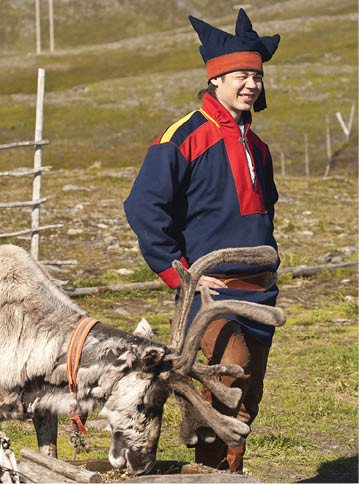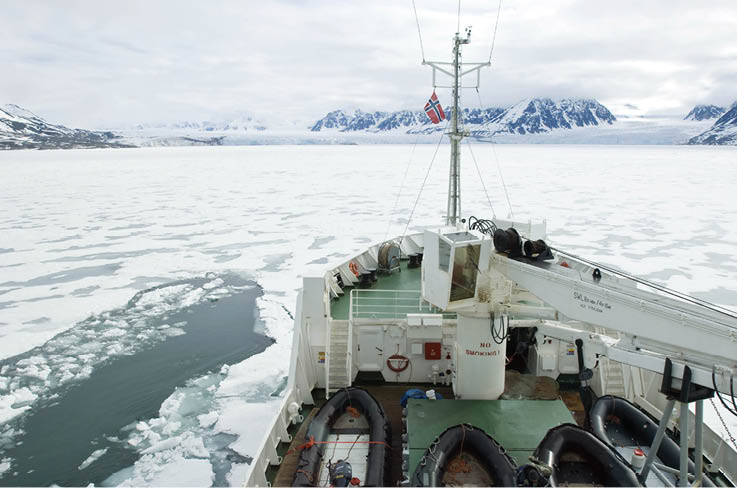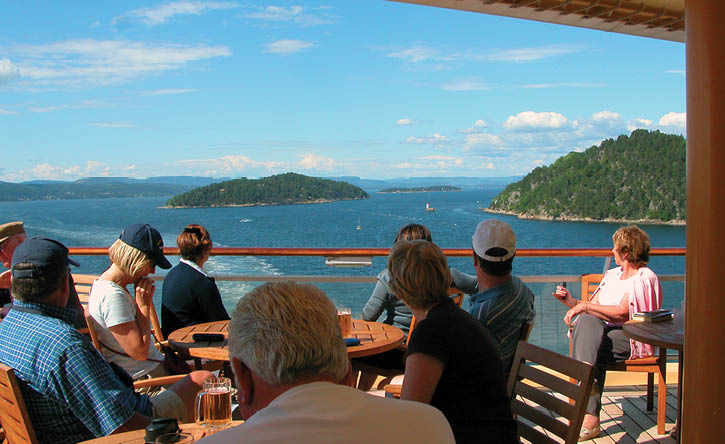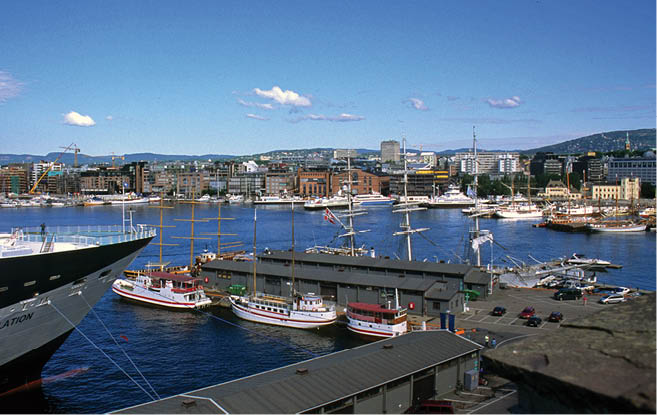Norway


Geirangerfjord is one of many stunning fjords hidden along Norway’s intricate coastline.
Norway is a land of boundless beauty with its breathtaking fjords and snowcovered mountain peaks. First attracting ship-borne tourists in the late 19th century, this rugged scenery has also shaped Norway’s national character – posing a challenge to survival but ultimately providing an abundance of natural riches.
Map of Norway

Barely a quarter of Norway’s total land area is productive with just five percent cultivated, but the country’s forests are an excellent source of timber, its fertile waters support a large fishing fleet and its offshore seabeds contain oil deposits that have made modern Norway – which began as a network of farflung Norse settlements ruled by chieftains – into one of the world’s wealthiest nations.
Sparsely populated Norway is about three-quarters the size of California and has a population approaching five million. From 1825 to 1925, more than 800,000 Norwegians (about one-third of the population) immigrated to North America, many of them settling in the midwest of the United States where they farmed the fertile, flat land that was so scarce in their native Norway.
A mostly mountainous country dominated by a deeply indented coastline, Norway’s northern territory extends well beyond the Arctic Circle where the Sami of Lapland have herded Arctic reindeer for centuries. The sun never fully sets in summer in Norway’s northern regions, and in southern Norway there are 21 hours of daylight (from about 3:00 a.m. to 11:00 p.m.)
Norway is a parliamentary democracy and constitutional monarchy. Harald V has been the country’s king since 1991. May 17 is Constitution Day and this flag-flying holiday is celebrated nationwide with parades, festivities and the wearing of traditional dress.

Sami live in Norway’s north.
Norwegian and Sami are the country’s two official languages, but English is widely spoken. The state religion is Lutheran.
The unit of currency is the Norwegian krone (kr or NOK), which divides into 100 øre. The approximate rate of exchange is $1 US = 7 krone; £1 British pound = 11 krone.
The cost of living is high in Norway, and this is reflected in prices charged for goods and services. Tipping is appreciated (5 to 10 per cent) but a service charge is automatically added to hotel and restaurant bills. Major credit cards are accepted at most stores and restaurants, and by taxi drivers.
Norway’s country calling code is +47.

Fresh berries are a summertime treat in Norway.
Seafood is a popular dish in Norway, where locally caught cod, herring, shrimp and salmon are featured on restaurant menus. Pork-and-veal meatballs are also popular, as are such delicacies as smoked elk and reindeer sausage.
Waffles (thin, heart-shaped and served with whipped cream and strawberry jam or berries) are popular, as are sveler – Norwegian pancakes served with a spread of sugar and butter.

Serving up fresh shrimp at a food stand.
Domestic cheeses include the famous Jarlsburg cheese – a semi-firm, yellow cheese that’s distinctive for its slightly sweet and nutty flavour and for its small, round holes.
Restaurant and bar prices in Norway are very high, with a glass of beer costing about $12.

High-quality Norwegian knitwear.
Shopping items to look for include hand-knitted sweaters in Nordic designs and wood-carved items decorated with patterns inspired by the Norwegian folk art of rosemaling (rose painting).
Another unique Norwegian craft is Hardanger embroidery, which traditionally utilized white thread on white cloth to create a geometric block pattern (diamonds, squares, etc.) for decorating bunads (long aprons). Today, coloured thread is also used in traditional and contemporary styles for embroidering cushions and table linens.
Other souvenirs include hand-made pewter jewellery, trolls (dolls representing creatures from Norse mythology) and a wide range of Viking-themed mementos.
Stores displaying a tax-free shopping logo will issue a tax-free voucher for the amount of Value Added Tax you paid on purchases exceeding NOK 315. Visit www.globalblue.com for details on obtaining a refund.

Norwegian polar explorer Fridtjof Nansen.
King Harald, who claimed to descend from the Viking gods, was the first chieftain to unite Norway under one ruler in about 900. He then set his sights on lands lying to the west, conquering the Shetlands and Orkneys. Skilled seafarers, the Norsemen proceeded to raid parts of Western Europe, establishing the Norse duchy of Normandy and laying claim to Iceland and Greenland. But dynastic feuds threatened to tear the country apart until King Sverre was able to consolidate royal power. Throughout the 13th century Norway enjoyed peace and prosperity, and its capital, Trondheim, was an important Christian centre and place of pilgrimage.
All this changed in the 14th century with the political union of Denmark, Sweden and Norway (the Kalmar Union), which resulted in Norway being ruled by Danish governors for the next four centuries. This period of Norwegian history was later characterized by the playwright Henrik Ibsen as “twice two hundred years of darkness.” The 19th century was the turning point for Norway, which was ceded by Denmark to Sweden in 1814. Despite Sweden recognizing Norway as an independent kingdom, their union was strained by a rising Norwegian nationalism, which culminated in Norway’s peaceful separation from Sweden in 1905. The majority of Norwegians voted in favour of a constitutional monarchy versus a republic as their nation’s form of government, and a Danish prince was chosen to be their new monarch. He was crowned Haakon VII, but the man who best personified Norway’s newfound nationalism was Fridtjof Nansen.
An explorer, scientist, statesman and humanitarian, Nansen first caught the world’s attention when, in 1888, he led an expedition on skis across the Greenland ice sheet. However, the achievement for which he has earned enduring fame – and an iconic status in Norway – was his amazing attempt a few years later to reach the North Pole. His ship, the Fram (which means forward), got stuck in the pack ice but – as Nansen had predicted – the prevailing ocean currents carried it slowly toward the North Pole. However, after a year spent drifting westward aboard the icelocked Fram, Nansen and crewmember Hjalmar Johansen left the ship and attempted to reach the North Pole with skis, kayaks, sledges and sled dogs. Enduring brutal conditions, they came within 226 miles (364 km) of the North Pole before turning south toward Franz Josef Land where they were rescued a year later upon a chance encounter with a British explorer named Frederick Jackson.

Norway’s Arctic waters.
Nansen and Johansen returned to a hero’s welcome in Norway, as did the crew of the Fram a few weeks later. Not only had Nansen proved his theory about a polar current, he had discovered that the Arctic was an ocean capped by an ever-shifting ice pack. Nansen became an international celebrity and the information he gathered on his brilliant exploit became the basis for all future Arctic work. He took on the role of statesman when working toward Norway’s independence from Sweden in 1905, and he won a Nobel Peace Prize in 1922 for his international work with refugees.
German forces occupied Norway during World War II, but the majority of Norwegians fought back with armed resistance or civil disobedience, while the country’s large merchant navy played a key role in Allied war operations, from the evacuation of Dunkirk to the Normandy landings. King Haakon, married to an English princess, headed a government in exile from London during the German occupation of Norway from 1940 to 1945.
Norway joined NATO after the war, and many of the state-controlled economic measures imposed during the war were continued as the country pursued a mixed economy of both extensive government ownership and free market activity. Norway joined the European Free Trade Association in 1959 but the Norwegian people have rejected joining the European Union.
The Norwegian government largely controls Norway’s oil and gas reserves and has established a state-owned pension fund – the largest such fund in Europe, with assets in the hundreds of billions of dollars.
Norway has come under criticism from environmentalists and animals rights activists for its stance on whaling (a centuries-old tradition in northern Norway) and its fish farming industry, despite concerns about contaminants in pen-raised salmon.

Cruising down Oslofjord.
Oslo, with a population of about half a million, is the largest city in Norway. It is scenically situated at the head of island-dotted Oslofjord where pine-forested hills overlook the city. A transportation hub with cruise ships, car ferries and tour boats docking along the harbourfront, Oslo is also Norway’s cultural centre with its many museums, art-adorned parks and historic buildings.
Map of Oslo

Oslo was founded by the Norse king Harald III in about 1000 AD and became Norway’s national capital in 1299, but the city lost its importance when Norway was incorporated into the Kingdom of Denmark. Following the devastating fire of 1624 during which most buildings (built of wood with turf roofs) were destroyed, a spacious new town was begun using brick and stone under order of King Christian IV, who renamed it Christiania.

Oslo harbour.
When Norway was ceded to Sweden in 1814, Christiania – although merely a small town – was reinstated as the country’s capital. A building boom followed, along with a massive influx of rural Norwegians seeking employment. The city’s Royal Palace became home to Norway’s new king when the country gained independence in 1905. The city’s name was officially changed back to Oslo in 1925. Oslo hosted the Olympic Winter Games in 1952, and celebrated its 1000th anniversary in the year 2000.